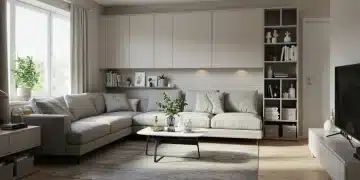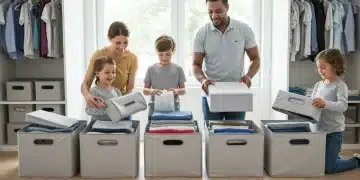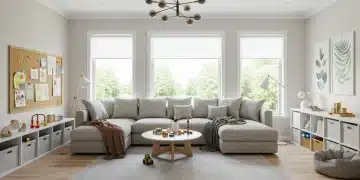Declutter Your Home & Mind: Family Guide 2025
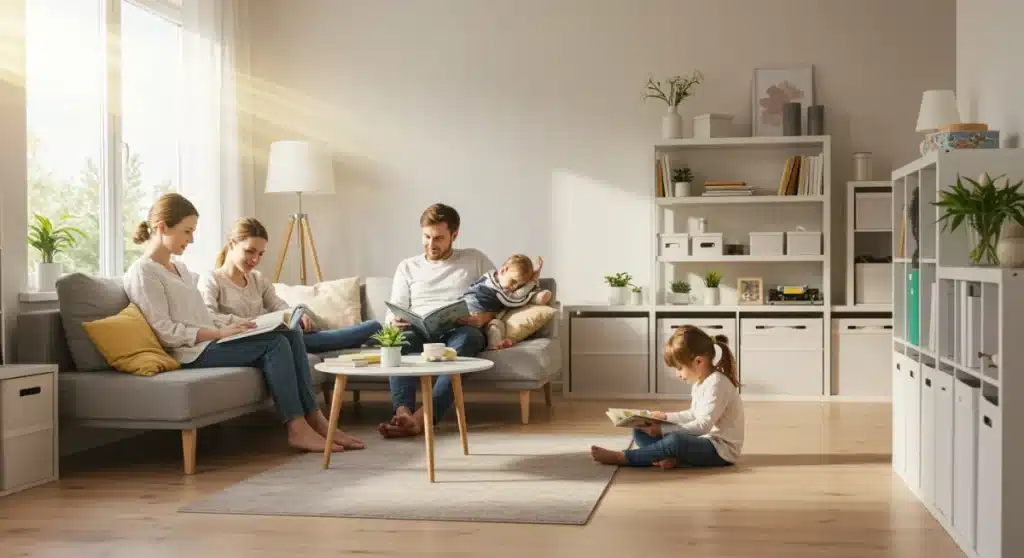
Advertisement
Effectively decluttering your home and mind in 2025 involves implementing systematic strategies for organization and mindful living, leading to a more harmonious and less stressful family environment.
Embarking on the journey to declutter your home and mind: a step-by-step guide for families in 2025 can seem daunting, yet its rewards are immeasurable. Imagine a living space where everything has its place, and a mental landscape free from the constant burden of disorganization. This guide is designed to help your family achieve just that, transforming chaos into calm one step at a time.
Advertisement
Understanding the Link Between Clutter and Mental Well-being
The state of our physical environment significantly impacts our emotional and psychological well-being. A cluttered home often translates into a cluttered mind, leading to increased stress, anxiety, and decreased focus. For families, this connection is even more pronounced, as shared spaces mean shared mental burdens.
Recognizing this intricate link is the first crucial step toward creating a more peaceful home and fostering greater mental clarity for every family member. When our surroundings are chaotic, our brains work harder to process information, leading to cognitive overload and a pervasive sense of being overwhelmed. This constant mental effort can deplete our energy reserves, making it difficult to relax, concentrate, or enjoy quality time together.
The Psychological Toll of Disorganization
Living amidst disarray can subtly erode our sense of control and contribute to feelings of inadequacy. Children, in particular, can be affected by their environment, often exhibiting behavioral issues or difficulty concentrating in overly stimulating or disorganized spaces. Creating an orderly home is not just about aesthetics; it’s about cultivating a sanctuary that supports mental health.
Advertisement
- Increased Stress Levels: Constant visual reminders of unfinished tasks or misplaced items can trigger a stress response.
- Reduced Productivity: Searching for items wastes time and disrupts workflow, whether for schoolwork or household chores.
- Impaired Focus: Clutter acts as a distraction, making it harder to concentrate on important tasks or engage in meaningful activities.
- Diminished Relaxation: A chaotic environment can make it challenging to unwind and truly relax at the end of the day.
By understanding how clutter impacts mental well-being, families can approach decluttering not as a chore, but as an investment in their collective happiness and peace of mind. The process becomes a mindful practice, where each item evaluated and decision made contributes to a lighter, more harmonious existence for everyone under the roof. This foundational understanding sets the stage for the practical steps that follow.
Setting Realistic Goals and Involving the Whole Family
Successful decluttering in a family setting requires a collaborative approach and achievable goals. Trying to tackle the entire house in one weekend is often a recipe for burnout and frustration. Instead, break down the process into smaller, manageable steps, and ensure everyone in the family understands their role and the benefits of a clutter-free environment.
Start by having an open family discussion about why decluttering is important for everyone. Explain how less stuff can lead to more space for activities, easier clean-up, and a calmer atmosphere. When children feel heard and understand the purpose, they are more likely to participate enthusiastically rather than feeling forced.
Communicating the Vision and Benefits
Before diving into sorting, sit down as a family to create a shared vision for your home. What does a decluttered space look like to each person? How will it feel? This collective imagining can be a powerful motivator. Discuss specific areas that cause stress and how decluttering them can improve daily life.
- Family Meeting: Schedule a dedicated time to discuss decluttering goals and expectations.
- Identify Problem Areas: Ask each family member to name one area they’d like to see improved.
- Highlight Positive Outcomes: Focus on the benefits such as more play space, easier mornings, or less stress.
- Define Shared Responsibilities: Assign age-appropriate tasks to ensure everyone contributes.
Establishing realistic goals is paramount. For young children, a goal might be to clear their toy bin. For teenagers, it could be organizing their desk. For adults, it might be tackling a specific closet. Celebrate small victories along the way to maintain momentum and reinforce positive habits. By involving the whole family from the outset, you build a sense of shared ownership and responsibility, making the journey toward a decluttered home a collective success story.
The Step-by-Step Decluttering Process: Room by Room
Once goals are set and the family is on board, it’s time to roll up your sleeves and begin the practical work of decluttering. The most effective approach is to tackle one room, or even one section of a room, at a time. This prevents overwhelming feelings and allows for visible progress, which is incredibly motivating.
Begin with a less emotionally charged area, like a laundry room or a pantry, to build confidence before moving to more personal spaces. The key is consistency and focus. Avoid jumping from one area to another without completing the first, as this often leads to more disarray.
Implementing the ‘Four Box Method’
A highly effective strategy is the ‘Four Box Method.’ For each item you encounter, make a quick decision and place it into one of four designated boxes (or piles): Keep, Donate/Sell, Relocate, or Trash. This method forces immediate decision-making and prevents items from lingering in limbo.
- Keep: Items that are frequently used, loved, or truly necessary. These should have a designated home.
- Donate/Sell: Items in good condition that are no longer needed but could benefit someone else.
- Relocate: Items that belong in another room or area of the house. Don’t put them away immediately; gather them and move them all at once.
- Trash: Broken, expired, or unusable items that cannot be donated or recycled.
As you progress through each room, involve family members in their respective areas. For children’s rooms, allow them to make decisions about their toys and clothes, guiding them with questions like, “Do you still play with this?” or “Does this fit you?” Make it a game or a challenge to keep them engaged. Remember, the goal is not perfection, but significant improvement and the establishment of sustainable habits. This methodical approach ensures that every corner of your home receives attention, leading to a truly decluttered and functional living space.
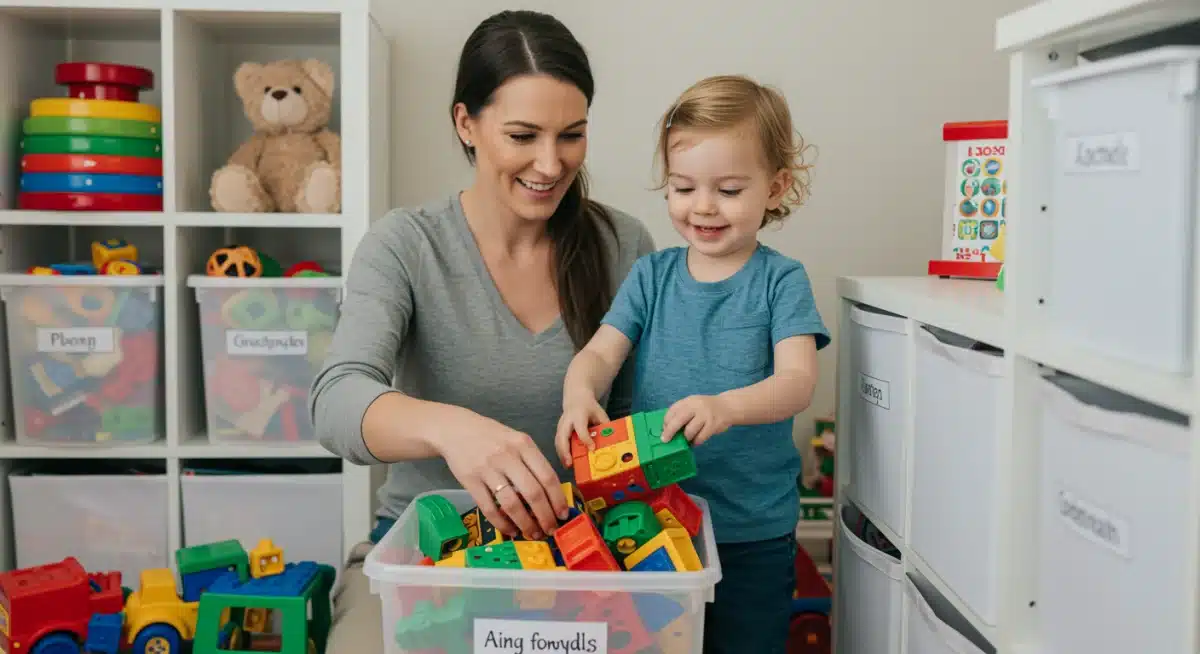
Strategies for Maintaining a Clutter-Free Home Long-Term
Decluttering is not a one-time event; it’s an ongoing process that requires consistent effort and the adoption of new habits. Once your home is organized, the real challenge lies in maintaining that order amidst the daily ebb and flow of family life. Establishing routines and systems is crucial for preventing clutter from creeping back in.
Think of maintenance as a series of small, daily actions rather than large, infrequent overhauls. These micro-habits, when consistently applied, create a powerful barrier against accumulating unnecessary items and ensure that your home remains a peaceful sanctuary. Everyone in the family plays a role in upholding these new standards of organization.
Implementing Daily and Weekly Routines
One of the most effective strategies is to integrate short decluttering bursts into your daily routine. A “five-minute tidy” before bedtime, where everyone puts away a few items, can make a significant difference. Weekly, dedicate a slightly longer period, perhaps 15-30 minutes, to reset common areas and address any accumulating items.
- “One In, One Out” Rule: For every new item that enters the house (e.g., a new toy, a new piece of clothing), one similar old item must leave.
- Designated Homes: Ensure every item has a specific place to live. If it doesn’t, it’s either clutter or needs a new home assigned.
- Vertical Storage Solutions: Utilize shelves, wall organizers, and stackable bins to maximize space and keep surfaces clear.
- Regular Purges: Schedule seasonal or annual decluttering sessions to re-evaluate items and prevent accumulation.
Involve children in these routines by making them responsible for their own belongings. Teach them the importance of putting things away immediately after use. For example, after playing, toys go back into their designated bins. After wearing clothes, they go into the hamper or closet. These consistent practices, reinforced by parents, instill valuable organizational skills that will benefit children throughout their lives. By consciously integrating these strategies, families can enjoy the lasting benefits of a consistently clutter-free and harmonious home.
Decluttering Your Digital Life for Mental Clarity
In 2025, clutter isn’t confined to physical spaces; it extends significantly into our digital lives. A chaotic digital environment—overflowing inboxes, disorganized files, and endless notifications—can be just as detrimental to mental well-being as physical clutter. Addressing digital disarray is an essential component of a holistic decluttering strategy for families.
Just as a tidy home reduces visual noise, an organized digital life minimizes mental distractions and improves efficiency. For families, this means setting boundaries around screen time, managing shared devices, and teaching digital organizational skills to children from a young age. The goal is to create a digital landscape that serves, rather than overwhelms.
Taming the Digital Beast: Practical Steps
Start by tackling the most common culprits of digital clutter: email inboxes and desktop files. Schedule dedicated time, just as you would for physical decluttering, to go through these areas systematically. The principles of keeping, deleting, and organizing apply equally to digital items.
- Email Management: Unsubscribe from unnecessary newsletters, delete old emails, and create folders for important correspondence. Aim for an “inbox zero” approach.
- File Organization: Create a logical folder structure for documents, photos, and school assignments. Regularly delete duplicate or old files.
- Photo Archiving: Consolidate photos from various devices, delete blurry or redundant shots, and back up important memories to cloud storage or external drives.
- App & Software Audit: Delete unused apps from phones, tablets, and computers. Organize frequently used apps into logical folders.
Beyond organization, consider the impact of notifications. Turn off non-essential alerts on all devices to reduce constant interruptions and improve focus. For children, establish clear rules about device usage, including designated “no-screen zones” or times. Teaching them to manage their downloads and files responsibly from an early age will foster good digital habits. By consciously decluttering your digital life, you create more mental space, reduce cognitive load, and reclaim valuable time, contributing significantly to overall family well-being in the digital age.
Creating Mindful Habits and a Peaceful Family Environment
Beyond the tangible act of decluttering, the ultimate goal is to cultivate a mindful approach to living that supports a peaceful family environment. This involves more than just organizing possessions; it’s about being intentional with our time, energy, and consumption. Mindfulness helps us appreciate what we have and resist the urge to constantly acquire more, thereby preventing future clutter.
A peaceful family environment isn’t just about the absence of chaos; it’s about the presence of calm, connection, and intentional living. When everyone in the household practices mindfulness, even in small ways, it creates a ripple effect, enhancing communication, reducing stress, and fostering deeper bonds.
Incorporating Mindfulness into Daily Family Life
Mindful habits can be integrated into everyday routines without requiring significant time commitments. These practices encourage family members to be present, appreciate their surroundings, and make deliberate choices about their possessions and activities.
- Intentional Purchasing: Before buying something new, ask: Do we truly need this? Does it add value to our lives? Where will it live in our home?
- Gratitude Practices: Regularly express gratitude for the items you have and the experiences you share as a family. This shifts focus from acquiring to appreciating.
- Mindful Moments: Encourage short periods of quiet reflection or deep breathing throughout the day, especially during transitions or before meals.
- Digital Detoxes: Implement regular periods where the entire family unplugs from devices, fostering real-world interactions and activities.
Teaching children mindfulness from a young age can equip them with valuable tools for managing stress and making conscious choices. Simple exercises, like a brief meditation before bed or a mindful walk in nature, can help them develop self-awareness and emotional regulation. By consciously fostering these mindful habits, families can create an environment where peace, clarity, and intentional living are not just aspirations, but everyday realities. This holistic approach ensures that the benefits of decluttering extend far beyond physical spaces, enriching the mental and emotional lives of every family member.
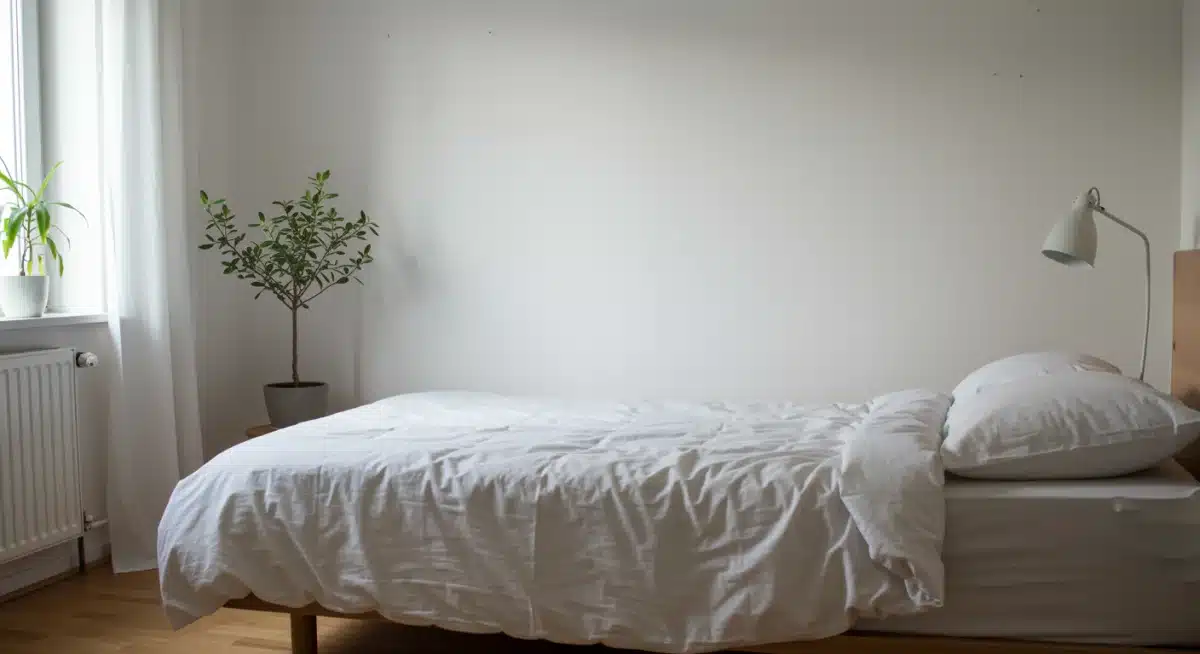
Overcoming Common Decluttering Challenges for Families
Even with the best intentions, families often encounter unique hurdles when trying to declutter. Sentimental attachment, differing organizational styles, and resistance from certain family members can derail progress. Recognizing these common challenges and having strategies to overcome them is key to sustained success.
It’s important to approach these obstacles with patience and understanding, especially when dealing with children’s attachments or a partner’s reluctance. Decluttering is a personal journey for each individual, even within a shared family goal. Empathy and flexibility will be your greatest allies in navigating these tricky waters.
Addressing Specific Obstacles
One of the biggest challenges is dealing with sentimental items. While it’s important to honor memories, not every memento needs to be kept in physical form. Digital photos, scrapbooks, or a single memory box can be excellent alternatives to a mountain of forgotten items. For children, allow them to choose a select few cherished toys to keep, explaining that letting go of others allows new children to enjoy them.
- Sentimental Items: Designate a small, specific container for cherished memories. Photograph items before donating to keep a digital record.
- Differing Styles: Compromise on shared spaces. Allow individual family members some autonomy over their personal rooms, within reasonable boundaries.
- Resistance from Children: Make it fun and empower them with choices. Frame it as making space for new adventures or helping others.
- Partner Buy-in: Focus on the benefits for them personally (e.g., less stress, easier to find things) rather than just the task itself.
Another common issue is the “just in case” mentality. Many items are kept because we *might* need them someday. Challenge this thought process by asking how often that “someday” actually arrives. For items not used in a year (or even six months), it’s often safe to let them go. Regular review of storage areas can also prevent items from accumulating unseen. By proactively addressing these challenges, families can maintain momentum and ensure their decluttering efforts lead to lasting peace and order, reinforcing the positive habits established throughout the process.
| Key Point | Brief Description |
|---|---|
| Clutter & Mind Link | Physical clutter negatively impacts mental well-being, causing stress and reduced focus for families. |
| Family Involvement | Set realistic goals and involve all family members to ensure collaborative and sustainable decluttering. |
| Digital Decluttering | Organize digital files, emails, and manage notifications to reduce mental distractions. |
| Mindful Habits | Cultivate intentional living and gratitude to prevent future clutter and foster peace. |
Frequently Asked Questions About Family Decluttering
For optimal results, families should aim for daily micro-decluttering sessions (5-10 minutes) and a more focused weekly tidy-up (30 minutes). Additionally, seasonal or annual deep dives are recommended to prevent significant accumulation and re-evaluate items effectively.
Make it fun and empowering. Give children choices about their belongings, explain the benefits of less clutter (more play space), and assign age-appropriate tasks. Reward their efforts and make it a collaborative activity rather than a chore.
Designate a specific, limited-size memory box for truly cherished items. Consider digitizing photos or creating scrapbooks for less tangible memories. Focus on the feeling the item evokes rather than the item itself, and let go of excess.
Absolutely. A decluttered home reduces stress and arguments over misplaced items, creates more space for shared activities, and fosters a calmer environment. This reduction in tension often leads to improved communication and stronger family bonds.
Digital decluttering reduces mental overload, improves focus, and saves time spent searching for files or managing notifications. It contributes to overall mental clarity, reduces screen-related stress, and frees up cognitive energy for more meaningful tasks.
Conclusion
The journey to declutter your home and mind: a step-by-step guide for families in 2025 is a transformative one, offering far more than just tidy spaces. By embracing systematic decluttering, involving every family member, and cultivating mindful habits, you create an environment that actively supports mental well-being, fosters stronger relationships, and promotes a sense of peace and order. This holistic approach ensures that your home becomes a true sanctuary, reflecting the calm and clarity you’ve cultivated within. The benefits extend beyond the physical, enriching the emotional and psychological landscape of your entire family for years to come.

